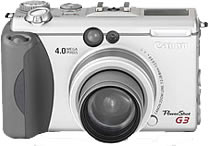 |
| Cannon
Powershot G3 |
WHILE the five
megapixel barrier has been broken and technology will soon deliver
"higher quality" pixels as well as quantity, for most
consumer purposes, even for prosumers (consumers dabbling in semi-professional
shooting), the 4.0 megapixel zone still features the highest level
of comfort, value and stability.
To begin with,
as we mentioned in our last article, you don't need a fantastic
number of pixels for run-of-the-mill point-and-shoot photography.
Those family holidays will turn out fine on a glossy four-by-six-inch
print with just two megapixels (two million pixels). Another useful
measurement is "effective pixels" which determines the
actual resolution. This eliminates redundant pixels.
In the final
analysis, the key issue is your camera's "output resolution".
A camera that outputs a1,600x1,200 pixel resolution gives you two
million pixels of output (if you multiply the two numbers). And
two million megapixels is normally enough for most photography.
Send us your Feedback / Letter to the Editor
 Share This Page Share This Page
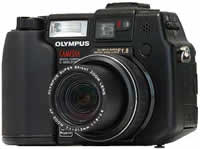 |
| Olympus
Camedia C-5050 |
A wonderful
camera we featured in our last review turns up again, entirely on
merit. It looks good, handles well and produces great results. The Canon PowerShot G3 delivers 4.0 megapixel resolution with
a 4x optical zoom lens offering the equivalent of 35mm-140mm. The
camera also shoots three minutes of movie with audio though it must
be remembered video on a digital camera is really a side trick.
We don't advise buying a camera purely for video. For one, most
camera video is low resolution (which is fine for the Web if that
is your prime intention) and you cannot zoom while shooting. Decide
your requirement and then go for a specialist piece of equipment.
The G3 features flexi-zone auto-focus as well as manual focus and
images can be saved as high-quality RAW files or as JPEGS. Picture
quality is very good with colour on the warmer side. The macro mode
delivers sharp results while a "vivid" mode offers rich
colour enhancements. There is also an "intervalometer"
function that can set the camera to shoot at intervals of between
one minute and one hour. The design is rather boxy but the G3 is
excellent value for money. www.canon.com
Olympus Camedia
has churned out a series of successful models and its latest is
no slouch. The Olympus Camedia C-5050 shoots in five megapixels.
The lens is a 3x zoom, 35mm-105mm equivalent with a maximum aperture
of f1.8 (ahead of most current cameras). The C-5050 features a range
of settings, automatic as well as manual with five scene modes and
a customised personal setting as well. The body is sturdy, easy
to grip and handle. The functions take a moment to acclimatise to
but once this is done, the camera is remarkably simple to use.
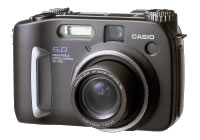 |
| Casio
QV-5700 |
Another interesting
feature of this Olympus is that it utilises not just one, but four
types of memory cards. The camera can be set to display a live histogram
but we imagine most punters will find little use for this. A histogram
is a bit like a graphic equalizer on a hi-fi system. Of course,
if your concept of music is settings and frequencies as opposed
to the actual sound, then, well… All in, the C-5050 is a good
camera with a fast "burst" rate and video but focusing
can sometimes wobble. It is perhaps the best-priced 5.0 megapixel
model on the market right now. www.olympus.com
Casio always
seem to have a few tricks up its sleeve and comes out with innovative
products in the blink of an eye. The latest is the Casio QV-5700 with a Canon 3x zoom lens with a 35mm-102mm equivalent range. This
is a snappy looking camera with a neat black body. It does everything
except samba and features video as well with both NTSC and PAL output.
It offers a poster-busting 5.0 megapixel output and is packed with
features like filters including one that casts a purple hue over
your picture. Purple? Picture quality is good and the camera is
easy to use with controls easily accessed on the body. The only
quibble might be that it could have featured a 4x zoom lens. This
model probably carries the Canon G2 lens. Well, you can't have everything. www.casio.com
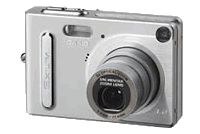 |
| Casio
EX-Z3 |
Jumping back
to miniatures, Casio's "wearable" Exilim line now has
the ultra-trendy ultra-slim EX-Z3 with 10mb built-in memory
and a Pentax 3x optical zoom lens, a 35mm-105mm equivalent. This
picks up where the EX S2 and M2 left off. There is an additional
4x digital zoom and a reasonable two-inch LCD monitor. Video buffs
can shoot 30 seconds of continuous movie with audio in one burst
at 320x240. The Exilim mini features three recording modes - normal,
best shot and movie. It weighs 2.5 ounces and generates three million
pixels which is quite a wallop for its near credit-card size. The
camera can register up to 21 settings if you're one of those that
can't make up their minds. There is also a two-in-one function that
permits you to place two subjects together on a single image. The
camera is ready to shoot in a little over a second. If you want
heads to turn every time you produce your little silver accessory,
this is perhaps the camera for you. www.casio.com
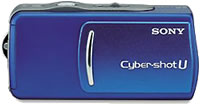 |
| Sony
Cybershot U20 |
Not to be outdone,
Sony have trundled out, or rather, flicked out, their new Sony
Cybershot U20. This is a 70gm wonder that produces two million
pixels and does movies (without sound). Your images go onto Sony's
proprietary Memory Stick (the U20 comes with an 8mb card). The colour
reproduction is reasonably faithful though tones tend to warm up
a bit.
This means more
red in the cheeks, if not in the eyes (as the camera has red-eye
reduction). The Cybershot U20 features a sliding case that covers
the lens and the entire gizmo could fit easily in the tiniest of
pockets. Just don't swallow it one morning along with your vitamins.
It is dead easy to use as controls are minimal. The fixed lens is
the equivalent of a 33mm. www.sony.com
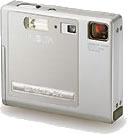 |
| Minolta
Dimage Xi |
Another little
wonder is the Minolta Dimage Xi which features a rather revolutionary
3x "folded" zoom lens (with additional 4x digital zoom).
The lens works within the small case and does not protrude as in
conventional cameras. Why? The Xi can also record video with audio
(at 320x240 resolution) up to 35 seconds in one burst. Or a 90-second
audio clip.
And all this
with a 3.0 megapixel output with images stored in JPEG or TIFF format.
Buttons are uncomplicated and few. A super point-and-shoot package,
but make sure you don't get your fingers in your pictures. Hold
the camera carefully and keep those fingers away from the lens.
The ISO range runs to just 400 and there is little manual control
- like shutter or aperture priority settings. The Dimage Xi weighs
in at an ultra-light 130g in an ultra-slim package that will certainly
cause heads to turn. One advantage is the fast start-up. You can
switch the gizmo on and start shooting within just over a second.
Of course, as we said before, watch out for those fingers.
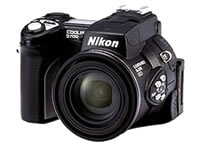 |
| Nikon
Coolpix 5700 |
We looked at
the Nikon Coolpix 4300 in our last article. It did well. The new Nikon Coolpix 5700 (which moves beyond the 5000 model mainly
on zoom features) is a five megapixel star save for one little hitch
- the controls. These are labyrinthine and our bet is you will not
find the video activation control within fifteen minutes of scrolling
through menus and sub-menus. Not a camera for novices though the
end results are superb.
With that out
of the way it must be said the Coolpix 5700 is a remarkable, semi-professional
camera with 8x zoom (35mm to 280mm equivalent), a maximum shutter
speed of 1/4000, and an ultra high speed continuous shooting mode
which enables three frames per second. The camera has great colour
response (including for neutrals) and relatively low "noise".
At higher ISO settings like 800 you might see a fair bit of "noise"
(grain and disturbance) but at normal everyday settings the Coolpix
5700 produces rich tones and saturated colours. Its macro setting
is outstanding and weighing in at a very reasonable 480gm it is
not too heavy to lug about. A useful camera for hobbyists bordering
on professional though a small quibble is the relatively average
battery life.
 |
| Nikon
Coolpix 3500 |
The Coolpix
3500 is a smaller, elegant, "designer" contender.
It features a lens that swivels within the camera frame, a 3.2 megapixel
output and a 3x zoom lens. Exposure control and focusing are good
though you will need to remember not to get your fingers pinched
between frame and body. Even the manual offers this warning: "Care
should be taken to avoid catching fingers, hair, or clothing between
the lens section and the camera body." Amen. The camera can
shoot 35-second movies. There is no sound though. A decent option
for novices with a snap-happy finger - and short hair. www.nikon.com
Send us your Feedback / Letter to the Editor |